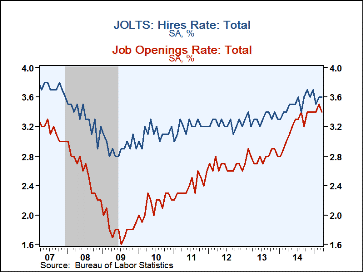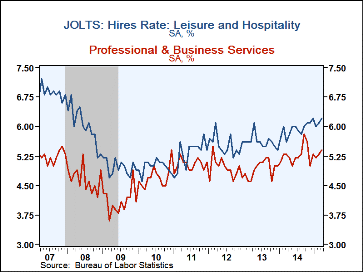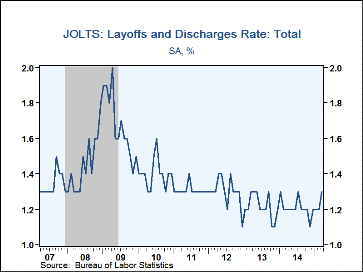 Global| May 12 2015
Global| May 12 2015U.S. JOLTS: Job Openings Rate Slips From Record High
by:Tom Moeller
|in:Economy in Brief
Summary
The job openings rate during March eased m/m to 3.4%. It remained up from the recession low of 1.6% but just below the series' high of 3.8% early in 2001. The job openings rate is the number of job openings on the last business day of [...]
The job openings rate during March eased m/m to 3.4%. It remained up from the recession low of 1.6% but just below the series' high of 3.8% early in 2001. The job openings rate is the number of job openings on the last business day of the month as a percent of total employment plus job openings. The actual number of job openings surged 18.6% y/y to 4.994 million versus 5.144 million in February, revised from 5.133 million. The Bureau of Labor Statistics reports these figures in its Job Openings & Labor Turnover Survey (JOLTS).
The private-sector job openings rate fell to 3.6% m/m but still was improved from the recession low of 1.7%. The rate in professional & business services improved to 4.8% while the rate in leisure & hospitality held at 4.7%, nearly the cycle high. In health care & social services it fell m/m to 4.0% and in trade, transportation & utilities it declined to 3.1%, remaining up from the recession low of 1.2%. The rate in the factory sector slipped to 2.5% and the construction sector's rate fell to 2.3%. The job openings rate in the government sector remained at 2.2% and was higher than the 2009 low of 1.1%.
The hires rate held at 3.6%. The hires rate is the number of hires during the month divided by employment. The private sector hires rate recovered to 4.0%. Amongst leisure & hospitality firms, the rate improved to 6.2%. The rate in professional & business services gained to 5.4%. The construction sector rate backpedaled to 4.7%, its lowest level in six months. The hiring rate in education & health services eased to 2.7% and in the factory sector it held at 2.1%. In the government sector, the hiring rate nudged higher to 1.5%.
The number of hires improved 1.1% m/m (6.8% y/y). Private sector hires gained 0.8% (6.8% y/y). Construction sector jobs jumped 14.7% y/y and leisure & hospitality hiring strengthened 13.4% y/y. Health care & social services employment advanced 5.3% y/y. Professional & business services jobs increased 5.3% y/y and factory sector jobs improved 0.8% y/y. Government hiring rose 7.1% y/y.
The job separations rate returned to its recovery high of 3.5% and the actual number of separations increased 10.3% y/y. Separations include quits, layoffs, discharges, and other separations as well as retirements. The private sector separations rate edged up to 3.9% while the government sector's rate held at the five year high of 1.5%, for the third straight month. The layoff & discharge rate rebounded to 1.3%, the highest level since July. The private sector layoff rate edged up to 1.4% but the government's rate held at 0.5% for the fifth consecutive month.
The JOLTS survey dates to December 2000 and the figures are available in Haver's USECON database.
Changing Labor Force Composition and the Natural Rate of Unemployment from the Federal Reserve Bank of Chicago is available here.
| JOLTS (Job Openings & Labor Turnover Survey, SA) | Mar | Feb | Jan | Mar '14 | 2014 | 2013 | 2012 |
|---|---|---|---|---|---|---|---|
| Job Openings, Total | |||||||
| Rate (%) | 3.4 | 3.5 | 3.4 | 3.0 | 3.4 | 2.8 | 2.6 |
| Total (000s) | 4,994 | 5,144 | 4,965 | 18.6% | 22.6% | 9.3% | 3.2% |
| Hires, Total | |||||||
| Rate (%) | 3.6 | 3.6 | 3.5 | 3.4 | 42.2 | 39.8 | 38.8 |
| Total (000s) | 5,067 | 5,011 | 4,994 | 6.8% | 8.4% | 3.4% | 4.2% |
| Layoffs & Discharges, Total | |||||||
| Rate (%) | 1.3 | 1.2 | 1.2 | 1.2 | 14.5 | 14.6 | 15.5 |
| Total (000s) | 1,793 | 1,688 | 1,722 | 6.5% | 2.4% | -4.9% | 1.1% |
Tom Moeller
AuthorMore in Author Profile »Prior to joining Haver Analytics in 2000, Mr. Moeller worked as the Economist at Chancellor Capital Management from 1985 to 1999. There, he developed comprehensive economic forecasts and interpreted economic data for equity and fixed income portfolio managers. Also at Chancellor, Mr. Moeller worked as an equity analyst and was responsible for researching and rating companies in the economically sensitive automobile and housing industries for investment in Chancellor’s equity portfolio. Prior to joining Chancellor, Mr. Moeller was an Economist at Citibank from 1979 to 1984. He also analyzed pricing behavior in the metals industry for the Council on Wage and Price Stability in Washington, D.C. In 1999, Mr. Moeller received the award for most accurate forecast from the Forecasters' Club of New York. From 1990 to 1992 he was President of the New York Association for Business Economists. Mr. Moeller earned an M.B.A. in Finance from Fordham University, where he graduated in 1987. He holds a Bachelor of Arts in Economics from George Washington University.










